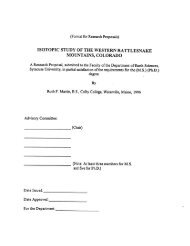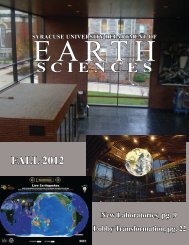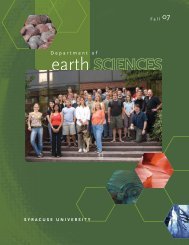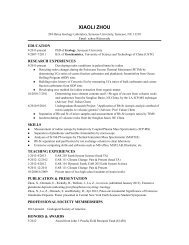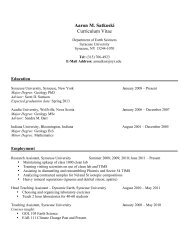alumni reception - Syracuse Universe Department of Earth Sciences ...
alumni reception - Syracuse Universe Department of Earth Sciences ...
alumni reception - Syracuse Universe Department of Earth Sciences ...
You also want an ePaper? Increase the reach of your titles
YUMPU automatically turns print PDFs into web optimized ePapers that Google loves.
Hansen, Doidge, along with Hume, Popper, Peirce,<br />
and others. They also do quite a bit <strong>of</strong> writing and<br />
revising. The class is intense and demanding for both<br />
pr<strong>of</strong>essors and students. We use visitors in both the<br />
sciences and the arts, to stimulate and to challenge the<br />
Honors students, who come from fields that include<br />
Architecture, Engineering, English, Bioengineering,<br />
Math, Philosophy, Biology, Management, and<br />
Women’s Studies. Our experimental course – and<br />
especially the approach <strong>of</strong> really pushing the students<br />
to sharpen their detectors and to strengthen their skills<br />
<strong>of</strong> associative thinking -- has been pr<strong>of</strong>iled by the<br />
University, College in Honors Program in articles this<br />
year:<br />
http://honors.syr.edu/TheCapstoneMagazine/<br />
TheCapstone_S10.pdf (see p. 21) and http://thecollege.<br />
syr.edu/pressrelease/trischkadiffee2010.htm.<br />
been successful with the broad range <strong>of</strong> students in the<br />
course. It was a bit hectic at moments, as for example,<br />
when the Chile earthquake occurred on Saturday<br />
morning and the mini-lab on convergent margins was<br />
scheduled to begin on Monday morning.<br />
The shipwreck project has gone quite well<br />
and I am working to finish the first draft <strong>of</strong> the book<br />
in the months ahead. I have also been doing a series<br />
<strong>of</strong> public lectures on the project, including the AAAS<br />
keynote address in San Francisco last year. The<br />
database <strong>of</strong> 2038 shipwrecks from North Carolina is<br />
complete and fully searchable – using terms ranging<br />
from “brigantine” to “gold bullion”! – and has<br />
already drawn a great deal <strong>of</strong> attention in the marine<br />
archeology and maritime history world. The book also<br />
centers on marine and atmospheric processes as they<br />
relate to shipwrecks; the database has documented a<br />
remarkable history <strong>of</strong> hurricanes during the span 1526-<br />
1984. NOAA scientists sailing out <strong>of</strong> Woods Hole<br />
have recently used the Newton shipwreck database to<br />
search for and re-locate the wreck <strong>of</strong> YP-389, a tiny<br />
patrol boat that courageously held <strong>of</strong>f the famously<br />
aggressive U-701 for several hours, in a nautical<br />
version <strong>of</strong> David and Goliath. One NOAA director<br />
wrote to me that using the LORAN-C coordinates<br />
from the database they “sailed right to the shipwreck”.<br />
I am serving as the <strong>Department</strong> faculty’s<br />
Alumni Liaison this year and am enjoying hearing<br />
from you. Please write to me: crnewton@syr.edu.<br />
Cathryn Newton reacts to the surprise unveiling <strong>of</strong> a<br />
glass sculpture dedicated in her honor.<br />
On the other end <strong>of</strong> the spectrum, I taught<br />
approximately 390 students in Spring, 2010, in <strong>Earth</strong><br />
<strong>Sciences</strong> 105. Outstanding TA’s Dave Gombosi,<br />
Aleece Nanfito, Josh Taylor, and Nathan Graber<br />
worked with me to create a more interactive, minilab<br />
curriculum that was tightly integrated with the<br />
lecture material. We used the earthquakes in Haiti<br />
and Chile in the mini-labs, and in general developed<br />
a curriculum that was much more hands-on. We are<br />
currently developing a manuscript to submit to GSA<br />
TODAY on this approach. This real-time approach<br />
-- in which we imported examples from breaking<br />
geologic events during the semester and enfolded them<br />
in the experiments and assignments -- seems to have<br />
Scott Samson<br />
The past year was a very busy one for the<br />
isotope geochemistry group. After trips to England and<br />
Germany to ‘shop’ for mass spectrometers, I decided<br />
to purchase one from the English company Isotopx.<br />
The new instrument arrived in May 2010 and after a<br />
too-exciting evening we had it <strong>of</strong>f the loading dock<br />
and up on the third floor (see action photo!). Most<br />
<strong>of</strong> the summer is dedicated to thoroughly testing the<br />
instrument (with the occasional break to watch world<br />
cup soccer matches). The instrument is truly state-<strong>of</strong>the-art<br />
and we encourage all <strong>alumni</strong>, potential new<br />
students, and friends <strong>of</strong> the <strong>Department</strong> to come and<br />
see the new laboratory.<br />
As for ongoing research we continue to<br />
pursue our detrital zircon studies, including getting<br />
a grant from the US Geological Survey to study<br />
earliest Cambrian sandstones from the length <strong>of</strong> the<br />
Appalachians – one <strong>of</strong> many projects PhD student



